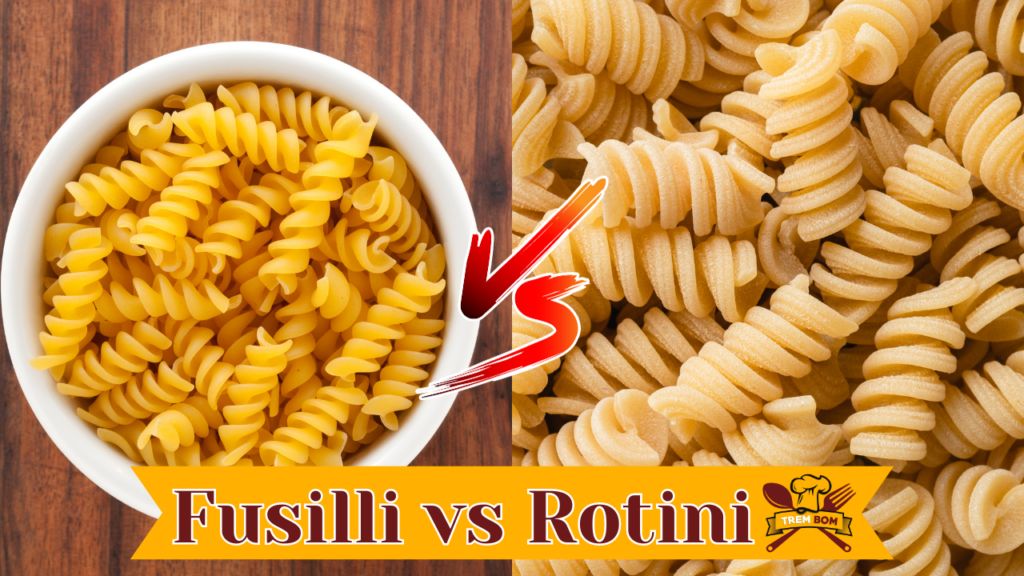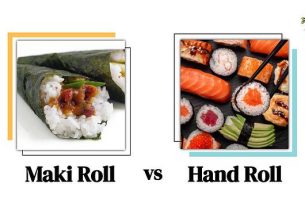Pasta, the beloved staple that has brought joy to countless meals, comes in endless varieties, each with its own unique shape and texture.
Among these, two contenders often grace the dinner table: fusilli and rotini.
These pasta cousins boast delightful twists and turns, tempting taste buds with their intriguing forms.
But what sets them apart?
Join us on a culinary adventure as we delve into the delicious world of fusilli and rotini, exploring their origins, characteristics, and the exciting possibilities they offer in your favorite recipes.
Get ready to unravel the mysteries of these spiral sensations and discover why they can be considered the champions of versatility in your kitchen.
fusilli vs rotini
Fusilli and rotini are two types of pasta that often get confused with each other.
The main difference between them lies in their shape.
Fusilli has larger spirals, while rotini has a tighter helix shape.
Fusilli is ideal for thicker sauces, while rotini is better for catching lighter sauces or using in pasta salads.
Fusilli originates from Southern Italy and is made from flat pasta strands spun around a thin rod.
It is usually made with flour, eggs, and egg yolk.
On the other hand, rotini is mainly made from semolina flour.
Both types of pasta can hold ingredients like meat, vegetables, sauce, and cheese.
Fusilli needs to be cooked for at least 12 minutes, while the cooking time for rotini may vary.
Despite their differences, fusilli and rotini can be used interchangeably in recipes as they taste the same and function the same in sauces.
Other substitutes for these pasta types include gemeli, cavatappi, rotelle, penne, and rigatoni.
Key Points:
- Fusilli and rotini are two types of pasta that are often confused with each other.
- The main difference between fusilli and rotini lies in their shape, with fusilli having larger spirals and rotini having a tighter helix shape.
- Fusilli is ideal for thicker sauces, while rotini is better for catching lighter sauces or using in pasta salads.
- Fusilli originates from Southern Italy and is made from flat pasta strands spun around a thin rod, while rotini is mainly made from semolina flour.
- Both types of pasta can hold ingredients like meat, vegetables, sauce, and cheese.
- Fusilli needs to be cooked for at least 12 minutes, while the cooking time for rotini may vary.
fusilli vs rotini – Watch Video
💡
Pro Tips:
1. Fusilli and rotini are both types of pasta that are commonly confused with each other. However, fusilli actually means “little spindles” in Italian, while rotini means “twists” or “spirals”.
2. Both fusilli and rotini have a similar shape with spiral or corkscrew-like patterns. However, rotini tends to have a tighter and more compact spiral shape compared to the looser and wider shape of fusilli.
3. Fusilli is traditionally known as a Southern Italian pasta, while rotini originated in Northern Italy. These regional differences have led to variations in the recipes and sauces that are commonly paired with each pasta.
4. The spiral shape of fusilli and rotini helps them hold onto sauces and ingredients. This makes them ideal for dishes with chunky or thick sauces, as the spiral grooves can trap the sauce and enhance the overall flavor and texture of the dish.
5. In terms of cooking time, rotini tends to cook slightly faster than fusilli due to its tighter shape and smaller size. This makes rotini a convenient choice for quick meals or when you’re in a hurry to have a delicious pasta dish on the table.
Fusilli Vs Rotini: Understanding The Differences
When it comes to pasta, there are many varieties to choose from. Two types that are frequently mistaken for each other due to their similar appearance are fusilli and rotini. However, there are several subtle differences that set these two pasta shapes apart:
-
Fusilli: This pasta shape features a spiral or corkscrew design. It is typically made using durum wheat flour and water. The spiral shape of fusilli makes it ideal for holding onto sauces, as the ridges help to capture and hold the flavors.
-
Rotini: Also known as “screws,” rotini is similar to fusilli in terms of its spiral shape. However, the spiral pattern of rotini is tighter and more compact. Like fusilli, rotini is made from durum wheat flour and water.
Despite their similarities, the main difference between fusilli and rotini lies in the tightness and size of their spirals.
In conclusion, while fusilli and rotini may look alike, the shape and size of their spirals differentiate them. The choice between the two ultimately comes down to personal preference and the specific recipe being prepared.
- Bullet point 1
- Bullet point 2
Spiral Size Comparison: Fusilli Vs Rotini
One of the most noticeable distinctions between fusilli and rotini lies in the size of their spirals. Fusilli boasts larger spirals that wrap around the pasta, providing a visually striking appearance. On the other hand, rotini features a tighter helix shape, making it look like a small corkscrew. These differences in spiral size can impact the eating experience, texture, and the way the pasta holds sauces.
Sauce Compatibility: Fusilli For Thick, Rotini For Light
When choosing between fusilli and rotini, their sauce compatibility is an important factor to consider.
- Fusilli’s larger spirals and grooves make it an excellent choice for heartier, thicker sauces.
- These grooves allow the sauce to cling to the pasta, creating a harmonious and flavorful combination.
- On the other hand, the smaller helix shape of rotini is better suited for lighter sauces.
- The ridges and grooves of rotini help in catching and holding onto lighter sauces, resulting in a burst of flavor in every bite.
- Additionally, rotini is often used in pasta salads due to its ability to hold its shape and capture the essence of the accompanying ingredients.
The Origin And Making Of Fusilli Pasta
Fusilli pasta originated in Southern Italy, specifically in the regions of Campania and Basilicata. This pasta is made from flat strands of pasta that are spun around a thin rod, giving it its signature spiral shape. The name “fusilli” translates to “twisted” in Italian, perfectly capturing the essence of this pasta.
Variants Of Fusilli: Bucati And Lunghi
There are two notable variants of fusilli pasta: fusilli bucati and fusilli lunghi.
Fusilli bucati is essentially fusilli with a hollow center, allowing the sauce to penetrate and create a delightful burst of flavor.
Fusilli lunghi, on the other hand, refers to a longer version of fusilli that is ideal for dishes that require a more extravagant presentation.
Homemade Fusilli: Using A Pasta Shape Press Machine
If you’re feeling adventurous in the kitchen, you can try making your own fusilli pasta at home using a pasta shape press machine. This nifty tool allows you to create perfectly shaped fusilli by extruding the pasta dough through various interchangeable dies. By experimenting with different shapes and sizes, you can add a personal touch to your homemade pasta dishes.
Ingredients Comparison: Flour Vs Semolina Flour
The ingredients used in the production of fusilli and rotini pasta contribute to their subtle distinctions.
- Fusilli is made with a combination of flour, eggs, and egg yolk, resulting in a rich and velvety texture.
- Rotini, on the other hand, is primarily made from semolina flour, giving it a slightly chewier and heartier consistency.
This choice of ingredients not only affects the texture but also the flavor profile of each pasta type.
The Distinct Shapes Of Fusilli And Rotini
When comparing fusilli and rotini, the unique shapes that define each pasta type stand out. Fusilli pasta presents a helical shape, resembling a twisted rope or spring. Conversely, rotini features a corkscrew-like shape, forming a series of tight spirals along its length. These distinct shapes not only add to the aesthetic appeal of the pasta but also offer practical advantages when it comes to holding ingredients.
Versatile Pasta: Holders Of Ingredients
Both fusilli and rotini pasta are excellent at holding ingredients, making them popular choices in a variety of dishes. They are perfect for adding chunks of meat, colorful vegetables, rich sauces, or melted cheese, as they provide the perfect canvas for creating flavorful and satisfying meals. The grooves, ridges, and spirals of fusilli and rotini serve to trap and distribute the ingredients evenly, guaranteeing that every bite is bursting with flavor.
- Fusilli and rotini pasta are great for holding ingredients
- They are versatile and can be used in a variety of dishes
- The grooves, ridges, and spirals help distribute the flavors evenly
- These pasta shapes are ideal for creating flavorful and satisfying meals.
“Both fusilli and rotini pasta provide the perfect canvas for creating flavorful and satisfying meals.”
Cooking Time Difference: Fusilli Vs Rotini
When it comes to cooking pasta, timing is crucial. Fusilli pasta typically requires a minimum cooking time of 12 minutes to reach the perfect al dente texture. On the other hand, the cooking time for rotini pasta may vary, as it tends to cook slightly faster due to its smaller and more compact shape. Whether you prefer a slightly softer or firmer texture, it’s important to follow the recommended cooking times for each pasta type to achieve desired results.
In conclusion, while fusilli and rotini may seem similar at first glance, their differences become more apparent when examining their spiral size, sauce compatibility, origin, ease of homemade production, ingredient composition, shape, and cooking time. These delicate differences are what set these two pasta types apart, allowing them to shine in various culinary applications.
So, next time you find yourself standing in front of the pasta aisle, take a moment to appreciate and consider the nuances between fusilli and rotini before selecting the perfect pasta for your next meal.
- Fusilli pasta requires a minimum cooking time of 12 minutes
- Rotini pasta tends to cook slightly faster due to its smaller and more compact shape.
💡
You may need to know these questions about fusilli vs rotini
Can I substitute rotini for fusilli?
While rotini and fusilli may look similar and have comparable shapes, there are subtle differences that distinguish them. Fusilli has a tighter twist than rotini, allowing it to hold more sauce within its crevices. However, if you’re looking to substitute one for the other, rotini can still work fine in most recipes. Its similar length and shape make it a suitable replacement, ensuring that it will effectively trap sauce and deliver a satisfying texture. In particular, rotini shines in pasta salad recipes, providing a delightful spiral shape that blends well with various ingredients.
Why is fusilli called rotini?
Fusilli is called rotini due to its similar corkscrew-like shape, although with a slightly tighter screw. Rotini, meaning “small wheels” in Italian, originated in Southern Italy and gained its name for its resemblance to spinning wheels. This association with wheels led to the adoption of the name “rotini” for this particular shape of pasta. While fusilli and rotini closely resemble each other, the distinction lies in the degree of the spiral, making rotini’s screw slightly tighter than that of fusilli.
What is fusilli traditionally used for?
Traditionally, fusilli is renowned for its ability to capture and hold onto sauces and petite ingredients within its tight spirals. Its versatile nature makes it a popular choice in various dishes, from hearty tomato-based meat sauces like Bolognese to creamy and cheesy baked pasta. Furthermore, fusilli’s adaptability extends to cold pasta salads where its unique shape adds a delightful texture to the dish. Consequently, fusilli has become a staple in the culinary world, excelling in capturing and enhancing the flavors of different sauces and ingredients.
What is rotini called in Italy?
In Italy, rotini is known as fusilli. These delightful pasta shapes are skillfully crafted into corkscrew or helical forms, creating an enticing texture and appearance. Fusilli, a term derived from the Italian language, perfectly describes the captivating twist and twirl of this pasta variety. Whether enjoyed with a rich tomato sauce or combined with fresh vegetables and herbs, fusilli is a beloved choice in Italian cuisine, adding a touch of charm to any dish.
Reference source
https://www.momswhothink.com/fusilli-pasta-vs-rotini/
https://www.thespruceeats.com/what-is-fusilli-995688
https://sharethepasta.org/pasta-shapes/rotini/
https://www.delallo.com/fusilli/



